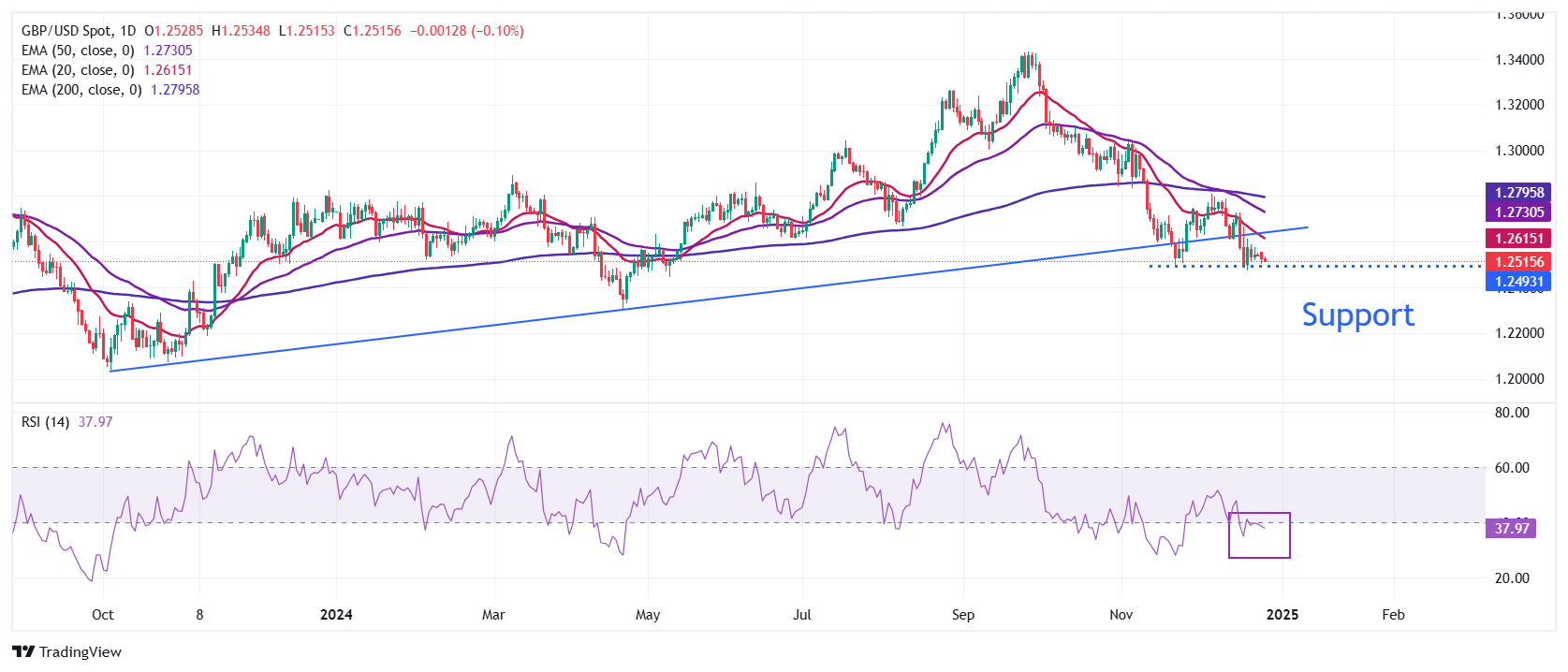- The British pound weakens slightly as investors expect the BoE to follow a less gradual policy easing cycle in 2025 than previously anticipated.
- Traders project at least two 25bp BoE interest rate cuts next year.
- US initial jobless claims dropped surprisingly to 219,000 last week.
The British Pound (GBP) posts minor losses against its major peers on Friday, with investors looking for fresh clues on how the Bank of England (BoE) will continue down the path of interest rate cuts in 2025. The latest policy announcement from the BoE in mid-December indicated a moderate buildup as the nine members of the Monetary Policy Committee (MPC) voted 6-3 to keep interest rates unchanged, a wider split than economists predicted of 8-1.
More BoE officials voting for an interest rate cut has led traders to gradually increase dovish bets for 2025. Markets currently see a 53 basis point (bp) cut in interest rates in 2025, up from 46bp after the BoE’s policy announcement on December 19, suggesting there will be at least two meetings in which officials will cut key interest rates by 25bp.
Meanwhile, BoE Governor Andrew Bailey has not guided a specific policy easing path for 2025, citing greater uncertainty in the UK economy.
Daily Market Summary: British Pound Trades in a Tight Range Against the US Dollar
- The British Pound oscillates in a tight range above the psychological support of 1.2500 against the US Dollar on Friday amid reduced trading volume following Christmas and Boxing Day. The GBP/USD pair is expected to continue trading sideways as activity will likely remain muted. However, any price action could be bearish as investors remain confident that the Federal Reserve (Fed) will deliver fewer interest rate cuts in 2025, supporting the USD. The US Dollar Index (DXY), which tracks the value of the greenback against six major currencies, is teetering around 108.00.
- Fed officials have collectively forecast that the federal funds rate will be at 3.9% by the end of 2025, suggesting there will be two interest rate cuts next year versus the four cuts projected in September. The Fed has become cautious about interest rate cuts as growth prospects are positive and the labor market remains firm.
- Initial jobless claims for the week ending December 20 have also been lower than expected. People filing for unemployment benefits for the first time dropped surprisingly to 219,000 from the previous release of 220,000. Economists expected the number of jobless claims to be higher, at 224,000.
- Furthermore, inflationary pressures have proven persistent in recent months. This scenario has renewed fears that price pressures will remain persistent.
- Looking ahead, the main trigger for the US dollar will be revised estimates of S&P Global manufacturing Purchasing Managers’ Index (PMI) and ISM data for December, due to be released next week.
Technical Analysis: British Pound Remains Weak with Declining Short and Long Term EMAs
The British Pound remains vulnerable against the US Dollar after a break below the ascending trend line around 1.2600, which is drawn from the October 2023 low at 1.2035.
All short-term and long-term exponential moving averages (EMAs) are sloping downwards, suggesting a strong long-term bearish trend.
The 14-day Relative Strength Index (RSI) falls below 40.00. A new downward momentum could be triggered if the oscillator remains below this level.
Looking down, the pair is expected to find support near the April 22 low around 1.2300 if it breaks below the immediate support of 1.2485. To the upside, the December 17 high at 1.2730 will act as key resistance.
British Pound FAQs
The British Pound (GBP) is the oldest currency in the world (AD 886) and the official currency of the United Kingdom. It is the fourth most traded foreign exchange (FX) unit in the world, accounting for 12% of all transactions, averaging $630 billion a day, according to 2022 data. Its key trading pairs are GBP/ USD, which represents 11% of FX, GBP/JPY (3%) and EUR/GBP (2%). The British Pound is issued by the Bank of England (BoE).
The most important factor influencing the value of the Pound Sterling is the monetary policy decided by the Bank of England. The Bank of England bases its decisions on whether it has achieved its main objective of “price stability” – a constant inflation rate of around 2%. Its main tool to achieve this is the adjustment of interest rates. When inflation is too high, the Bank of England will try to control it by raising interest rates, making it more expensive for people and businesses to access credit. This is generally positive for sterling, as higher interest rates make the UK a more attractive place for global investors to invest their money. When inflation falls too much it is a sign that economic growth is slowing. In this scenario, the Bank of England will consider lowering interest rates to make credit cheaper, so that companies will take on more debt to invest in projects that generate growth.
The data released measures the health of the economy and may affect the value of the pound. Indicators such as GDP, manufacturing and services PMIs and employment can influence the direction of the Pound.
Another important data that is published and affects the British Pound is the trade balance. This indicator measures the difference between what a country earns from its exports and what it spends on imports during a given period. If a country produces highly in-demand export products, its currency will benefit exclusively from the additional demand created by foreign buyers seeking to purchase those goods. Therefore, a positive net trade balance strengthens a currency and vice versa in the case of a negative balance.
Source: Fx Street
I am Joshua Winder, a senior-level journalist and editor at World Stock Market. I specialize in covering news related to the stock market and economic trends. With more than 8 years of experience in this field, I have become an expert in financial reporting.








